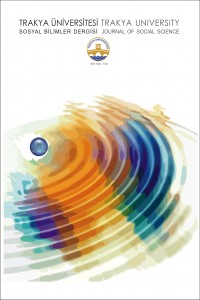Abstract
Gözleme dayalı olarak yapılan çalışmalarda birimlerin deney ve
kontrol gruplarına atanması sırasında araştırmacının kontrolü yoktur. Bu durum,
birimlerin hem demografik özellikleri hem de ortak değişkenleri bakımından
birbirlerinden farklılık göstermesine, dolayısı ile yapılacak olan tahminlerin hatalı
olmasına neden olacaktır. İşleyim etkisinin gözlenen ortak değişkenlere göre
koşullu olasılığı olarak ifade edilen Propensity Skor, iki gruptaki birimleri,
kullanılan değişkenler bakımından dengeleyerek hatanın azalmasını
sağlamaktadır. Yapılan çalışmaya, denizcilik sektörü gemi inşaat ve bakımında
faaliyet gösteren KOBİ’ler dahil edilerek ISO 9001:2000 KYS belgesi
sahipliğinin memnuniyet, aidiyet ve kobi çalışanlarının sorunları üzerinde
istatistiksel olarak anlamlı bir farklılık gösterip göstermediği test
edilmiştir. Aynı sermaye büyüklüğüne ve aynı sayıda iş gören sayısına sahip ISO
9001:2000 KYS belgesine sahip olan ve olmayan KOBİ’ler uygulama konusu olarak
tercih edilmiştir. Yapılan analizler sonucunda propensity skorların sapmaları
azaltarak sonuçları daha anlamlı hale getirdiği görülmüştür. Propensity Eşleştirmesi yapmadan önce ISO
9001:2000 KYS belgesi sahibi olan ve olmayan KOBİ çalışanları arasında
“Memnuniyet”, “KOBİ Çalışanlarının Sorunları” açısından anlamlı bir farklılık
çıkarken, “Aidiyet” açısından anlamlı bir farklılık çıkmamıştır. Propensity
Eşleştirmesi yapıldıktan sonra ise yukarıda ifade edilen İki ayrı KOBİ
çalışanları arasında “Memnuniyet”, “KOBİ Çalışanlarının Sorunları” ve “Aidiyet”
açısından farklılıkların anlamlı olarak ortaya çıktığı görülmüştür. Çalışma
sonucuna göre özellikle Tıp alanında yoğun olarak kullanılan Propensity
Skorların Sosyal Bilimlerde de güvenle kullanılabileceğinin belirtilmesi
yerinde olacaktır.
Keywords
References
- Altunok, E. Ç. (2005). “Gözleme Dayalı Çalışmalarda Propensity Skor ve Tıp Bilimlerinde Bir Uygulama” Yıldız Teknik Üniversitesi Fen Bil. Ens. (Yayınlanmamış Y.Lisans Tezi), İstanbul.
- Bewick, V., Liz C. ve Jonathan B. (2005). “Statistics Review 14:Logistic Regression”, Critical Care, 112-118.
- Bircan, H. (2004). “Lojistik Regresyon Analizi: Tıp Verileri Üzerine Bir Uygulama”, Kocaeli Üniversitesi Sosyal Bilimler Enstitüsü Dergisi, 185-208.
- Carey, G. M. H. (2006). Effectiveness of Physical Therapay fort he Management of Cronic Spine Disorders: A Propensity Score Approach, Research Report, Pysical Therap
- Cohen J. (2003). Applied Regression-Correlation Analysis for the Behavioral Sciences, Mahwah, NJ, USA: Lawrence Erlbaum Associates
- Cochran, W.G. (1965). “ The Planning of Observational Studies of Human Populations”, Journal of the Royal Statistical Society, 234-254.
- Cochran, W.G. (1968). “The Effectiveness of Adjustment by Subclassification in Removing Bias in Observational Studies”, Biometrics, 295-313.
- Çolak, C. vd, (2005). “Radial Arterde Ateroskleroz’un Tahmini ve Elde eden Risk Faktörler”,Uludağ Üniversitesi Tıp Fakültesi Dergisi,2005,147-151.
- D’Agostino, R. (1998). “Tutorial in Biostatistics Propensity Score Methods For Bias Reduction in the Comparison of a Non- Randomized Control Group”, Statistic in Medicine, 2265-2281
- Di Prete Thopmas A. ve Markus G. (2004). “Assessing Bias in the Estimation of Causal Effects: Rosenbaum Bounds on Matching Estimators and Instrumental Variables Estimation with Imperfect Instruments”, Sociological Methodology, 271-310.
- Freburger, J. K., Timothy S. C. ve George M H. (2006). “Effectiveness of Physical Therapy for The Management of Chronic Spine Disorders: A Propensity Score Approach”, Physical Therapy, 381-394.
- Frees, W. E. (2004). Longitudinal and Panel Data: Analysis and Applications in the Social Sciences, West Nyack, NY, USA: Cambridge University Press.
- Gatignon, H. (2003). Statistical Analysis of Management Data Secaucus, NJ USA:Kluwe Academic Publishers.
- Glynn, R. J.(2006). Sebastian Schneeweiss ve Til Stürmer, “Indıcatıons for Propensity Score and Review of their Use in Pharmacoepidemiology”, Basic & Clinical Pharamacology, 253-259.
- Hosmer, D. W. ve Stanley, L. (2002). Applied Logistic Regression, 2.Baskı, New York: John Wıley&Sons, Inc.
- Heller, G. ve Venkatramani E.S. (2004). “A Nonparametric Test to Compare Survival Distrubitions With Covariate Adjustment”, Journal of the Royal Statistical Society: Series B(Statistical Methodology), 719-733
- Hirano, K., Guide W. I. ve Greet, R.(2003). “Effıcıent Estimation of Average Treatment Effects Using the Estimated Propensity Score”, Econometrica, 1161-1189.
- Imbens, G. W.(2000). “The role of the Propensity Scoreis Estimating Dose Response Functions”, Biometrika, 706-710.
- Joffee, M. M., Paul R. R. (1999). “Invıted Commentary:Propensity Scores”, American Journal of Epidemiology, 327-333.
- Nagelkerke, N.J.D. (1991). Miscellenea A Note on a General Definition of Coefficient of Determination”, Biometrika, 691-692.
- Newgard, C. D., ve diğerleri (2004., “Advanced Statistics: The Propensity Score-A Method for Estimating Treatment Effect in Observational Research”, Academic Emergency Medicine, 953-961.
- Pasta, D. J., “Using Propensity Scores to Adjust for Group Differences: Examples Comparing Alternative Surgical Methods”. http://www2.sas.com, (17 Mayıs 2006).
- Rosenbaum, P.R. (1985) P.R, Observational Studies, New York: Sprınger-Verlag, Rosenbaum, Paul R. ve Donald B. Rubin(1985), “Constructing a Control Group Using Multivariate Matched Sampling Methods that Incarporate the Propensity Score”, American Statistican, 33-38.
- Rosenbaum, P.R. ve Donald, B. R.(1983). “The Cenral Role of The Propensity Score in Observational Studies for Causal Effects”, Biometrika, 41-55
- Rosenbaum, P.R., Donald B. R. (1985). “The Bias Due to Incomplete Matching”,Biometrics, 103-116.
- Rubin, D.B.(1977), “Assisgment to The Treatment Group on The Basis of A Covariate”, Journal of Educational Statistics, 1-26.
- Stürmer, T., v.d. (2006). “A Review of the Ağpplication of Propensity Score Methods Yielde İncreasing Use, Advantages in Specific Settings, but not Substatially Different Estimates Compared with Conventional Multivariable Methods”, Journal of Clinical Epidemiology, 437-447.
- Uslu, Ş. ve Yavuz D. (2002). “ Kobi’lerde Çaluışanların Sorunları Üzerine Bir Araştırma”, Erciyes Üniv. Sos. Bil.Ens.Derg., 173-184.
- Zanutto, E. L. (2006). “A Comparison of Propensity Score and Linear Regression Analysis of Complex Survey Data”, Journal of Data Science, 67-91.
Details
| Primary Language | Turkish |
|---|---|
| Journal Section | Article |
| Authors | |
| Publication Date | December 27, 2018 |
| Published in Issue | Year 2018 Volume: 20 Issue: 2 |
Cite
Trakya University Journal of Social Sciences is licensed under Creative Commons Attribution 4.0.

